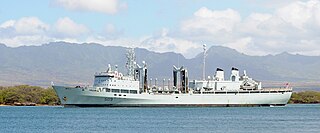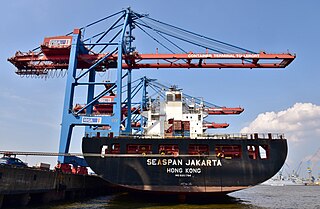
The Royal Canadian Navy is the naval force of Canada. The navy is one of three environmental commands within the Canadian Armed Forces. As of February 2024, the RCN operates 12 Halifax-class frigates, 12 Kingston-class coastal defence vessels, 4 Victoria-class submarines, 2 Harry DeWolf-class offshore patrol vessels, 8 Orca-class patrol vessels, and several auxiliary vessels. The RCN consists of 8,400 Regular Force and 4,100 Primary Reserve sailors, supported by 3,800 civilians. Vice-Admiral Angus Topshee is the commander of the Royal Canadian Navy and chief of the Naval Staff.
The Protecteur-class auxiliary oiler replenishment (AOR) ships were used by the Royal Canadian Navy to resupply ships at sea with food, munitions, fuel and spare parts. They had more sophisticated medical and dental facilities than smaller warships. At 172 metres (564 ft) the ships were some of the largest operated by the RCN. Entering service in 1969, the last vessel of the class was paid off in 2016.

HMCS Algonquin was an Iroquois-class destroyer that served in the Royal Canadian Navy (RCN) from 1973 to 2015.

HMCS Preserver was a Protecteur-class auxiliary oiler replenishment of the Royal Canadian Navy commissioned in 1970. Built at Saint John, New Brunswick and launched in 1969, the vessel took part in several overseas deployments, including Operation Deliverance, which became better known as the Somalia Affair. The ship underwent a major refit in 2005, after she was plagued by electrical problems. With these difficulties unresolved, Preserver was withdrawn from sea-going service in 2014 and was paid off on 21 October 2016. The vessel was broken up for scrap at Sydney, Nova Scotia in 2017.

Her Majesty's Canadian Ship (HMCS) Protecteur was the lead ship of the Protecteur-class replenishment oilers in service with the Royal Canadian Navy. She was part of Maritime Forces Pacific (MARPAC), homeported at CFB Esquimalt, British Columbia. Built by Saint John Shipbuilding and Dry Docks in Saint John, New Brunswick, she was commissioned on 30 August 1969. She was the first Canadian naval unit to carry the name Protecteur; however, there have been several units, including a base, named HMCS Protector.

Seaspan ULC provides marine-related services to the Pacific Northwest. Within the Group are three (3) shipyards, an intermodal ferry and car float business, along with a tug and barge transportation company that serves both domestic and international markets. Seaspan, is part of the Washington Companies that are owned by Dennis Washington. Kyle Washington, is the Executive Chairman of Seaspan, who has become a Canadian citizen.

The Type 702 Berlin-class replenishment ship is a series of replenishment ships, originally designed and built for service in the German Navy. Designed to support United Nations overseas missions, the Berlin class were initially to number four vessels. However, three hulls were cut from the initial order. The lead ship, Berlin, began construction in 1999 and entered service in 2001. The second hull, Frankfurt am Main, was re-ordered in 1998, began construction in 2000 and entered service in 2002. The third hull, Bonn, was ordered in 2008 to a modified design, began construction in 2010 and entered service in 2013. All three ships are in service and are based at Wilhelmshaven.
A joint support ship (JSS) is a multi-role naval vessel capable of launching and supporting joint amphibious and airlift operations. It can also provide command and control, sealift and seabasing, underway replenishment, disaster relief and logistics capabilities for combined land and sea operations.

HMCS Provider was a replenishment oiler and sole ship of her class of first the Royal Canadian Navy and later the Canadian Forces. She was the first dedicated auxiliary oiler replenishment ship commissioned for the Royal Canadian Navy in 1963, and the largest ship built in Canada to that date. Originally assigned to the East Coast, her open deck made her vulnerable and she was reassigned to the West coast. The ship was paid off in 1998, sold for scrap and broken up in Turkey in 2003.

Davie Shipbuilding is a shipbuilding company located in Lauzon, Quebec, Canada. The facility is now operating as Chantier Davie Canada Inc. and is the oldest continually operating shipbuilder in North America.
The Amphibious Assault Ship Project was a proposed procurement project by the Government of Canada for the Royal Canadian Navy (RCN). However, no such project was incorporated into the Government's defence plan Strong, Secure and Engaged released in 2017 and cost challenges with other naval procurement projects under the National Shipbuilding Procurement Strategy has led to no movement on the idea.

CCGS John G. Diefenbaker is the name for a Canadian Coast Guard icebreaker that had been expected to join the fleet by 2017 but has been significantly delayed. Her namesake, John G. Diefenbaker, was Canada's 13th prime minister. It was Diefenbaker's government that founded the Canadian Coast Guard in 1962.

Harry DeWolf-class offshore patrol vessels are warships of the Royal Canadian Navy (RCN) built within the Government of Canada Arctic and Offshore Patrol Ship (AOPS) procurement project, part of the National Shipbuilding Strategy. In July 2007 the federal government announced plans for acquiring six to eight icebreaking warships for the RCN.
The National Shipbuilding Strategy (NSS), formerly the National Shipbuilding Procurement Strategy (NSPS), is a Government of Canada program operated by the Department of Public Works and Government Services. The NSS was developed under the Stephen Harper Government in an effort to renew the fleets of the Royal Canadian Navy (RCN) and the Canadian Coast Guard (CCG). The strategy was broken into three sections; the combat package, the non-combat package and the smaller vessel package. The companies who won the bids for the larger ships were not permitted to bid on the smaller vessel package. In 2019 the Trudeau Government decided to add a third shipyard to the NSS specializing in the construction of icebreakers for the Coast Guard. The agreement to incorporate Davie as a third shipyard within the NSS was finally signed in April 2023.

MV Asterix is a Canadian commercial container ship. It was purchased by Federal Fleet Services as part of Project Resolve, and was later converted into a supply ship for the Royal Canadian Navy (RCN). She is intended to act as an interim replacement between the out of service Protecteur-class replenishment oiler and the future Protecteur-class auxiliary vessel. Originally launched in Germany in 2010 as Cynthia, the ship was converted and delivered to the RCN in December 2017 when she will be leased to the navy with a merchant navy crew, complemented by RCN personnel. Asterix will be in Canadian service well into the 2020s.

Project Resolve is the name of a pan-consortium made up of Chantier Davie Canada, Aecon Pictou Shipyard of Pictou, Nova Scotia and NavTech, a naval architectural firm, to develop an interim fleet supply vessel for the Royal Canadian Navy (RCN) until the previously-ordered Protecteur-class auxiliary vessels are complete. As of 2016, the project purchased MS Asterix, a commercial container ship, and is converting the vessel into an auxiliary naval replenishment ship that will be rented by the Royal Canadian Navy. The conversion was expected to be completed and the ship active in service by 2017. In late 2017, Davie proposed extending the project through the conversion of a second ship to ensure full capability for both the Atlantic and Pacific fleets.

HMCS Harry DeWolf is the lead ship of its class of offshore patrol vessels for the Royal Canadian Navy (RCN). The class was derived from the Arctic Offshore Patrol Ship project as part of the National Shipbuilding Procurement Strategy and is primarily designed for the patrol and support of Canada's Arctic regions. Named after Vice Admiral Harry DeWolf, a former head of the RCN, the vessel was ordered in 2011, laid down in 2016 and launched in 2018. The vessel completed contractors sea trials in July 2020, was delivered to the RCN on 31 July 2020 and began post-acceptance sea trials. Harry DeWolf was commissioned on 26 June 2021.

HMCS Margaret Brooke is the second Harry DeWolf-class offshore patrol vessel for the Royal Canadian Navy (RCN). The class was derived from the Arctic Offshore Patrol Ship project as part of the National Shipbuilding Procurement Strategy and is primarily designed for the patrol and support of Canada's Arctic regions. Named after Sub-Lieutenant Margaret Brooke, an RCN nursing sister who tried to save another person during the sinking of the ferry SS Caribou during World War II. Margaret Brooke was ordered in 2011, laid down in 2016 and launched in 2019. The vessel began contractor sea trials in May 2021, and it was delivered to the Royal Canadian Navy for post-acceptance sea trials on 15 July 2021. The official naming ceremony for the ship was conducted on 29 May 2022 in conjunction with that for sister ship Max Bernays. The vessel was commissioned on 28 October 2022.












